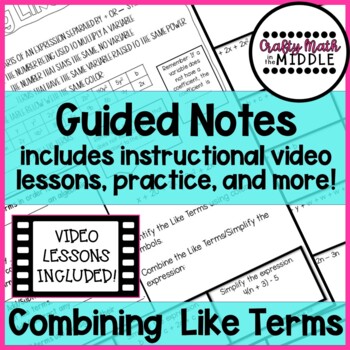Combining Like Terms Guided Notes, Video Lesson, Practice, & More
- PDF
Also included in
- This 6th grade Combining Like Terms Bundle includes all you need to teach Combining Like Terms-CCSS.6.EE.A.3 and CCSS.6.EE.A.4.Included in this bundle:-Guided Notes-Guided Practice-Independent Practice-Exit/Entrance Tickets-2 Video Lessons-Task Cards-Scavenger Hunt-Roll & Answer Math GamesPurchaPrice $10.00Original Price $11.50Save $1.50
Description
These Combining Like Terms or Simplifying Algebraic Expressions Guided Notes & Video Lessons will help you easily teach this concept. Video lessons are perfect for distance learning, a flipped classroom, lesson reinforcement, or absent students. The lessons are designed to help learners complete notes, learn/practice the skill, and have notes for future reference.
These guided notes are perfect for your interactive notebook. Notes include vocabulary, steps for solving, helpful tips, and guided practice. These notes are all you need for your students to put in their notebook to reference all year. The hand-written answer keys help to clearly show the steps to solving each problem.
Included in this resource:
-Guided Notes
-Guided Practice
-Independent Practice
-Exit/Entrance Tickets
-Hand-written answer keys with work shown
-YouTube & Google Drive Video Lesson link for Guided Notes (13:24 video length)
-YouTube & Google Drive Video Lesson link for Guided Practice (8:22 video length)
Tip - Leave feedback in order to get free products! Every piece of feedback given is turned into credits! Redeem credits on future purchases! I mean, who doesn't love free goodies?
©Sharon Garner –Crafty Math in the Middle - Your purchase provides you with one license for one classroom use/personal use only. Please purchase additional licenses for sharing purposes. This product may not be reproduced with the intent to resell. Thank you for honoring the time and effort put into this product!
Key Words: Combining Like Terms, Simplifying Algebraic Expressions, Algebra Terms, Guided Notes, Guided Practice, Video Lessons, Google Classroom, 6th grade math, 7th grade math, Flipped Classroom, Distance Learning






